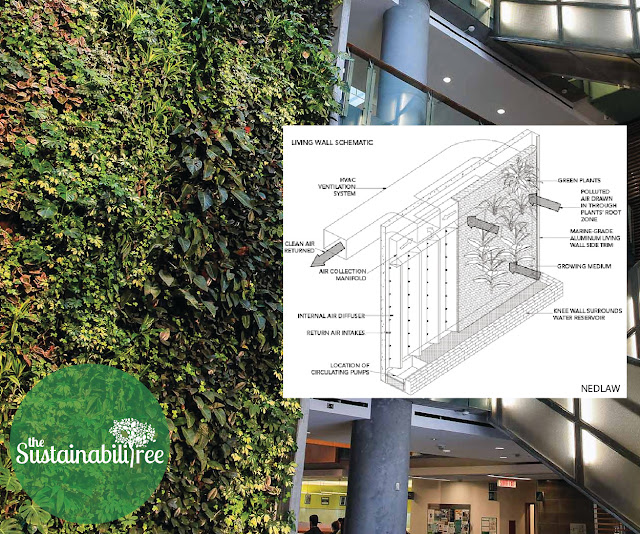I was recently asked to speak at a course about Technology, Society, and the Environment. The idea behind inviting me was to speak to the group about how campus sustainability has been helped along by technology. I thought that I might share this list with you too so you could learn a bit about the new, the old, the unconventional, and the interesting technologies that helped shaped our campus over the past few years.
The Living Wall
One of the most popular pieces of technology is the University of Ottawa's living wall. In fact, the wall is not just a pretty assortment of 1500 plants, it is a biofilter which is being used to help filter the air inside the FSS Building. The wall helps cleanse 80-85% of the volatile compounds in the air and it was also instrumental in helping solidify uOttawa's position as one of the top 17 Greenest Campuses in the world according to Interesting Engineering Magazine.
The technology used in the living wall isn't anything overly advanced, but it's beauty is more in what is does rather than how it works. The wall provides not only clean air but humidification and some much needed greenery. In a densely urban campus, sometimes the thing you need the most are some plants to help stave off nature deficit disorder.
District Energy
One of the very oldest systems on campus is the district energy loop, which is composed of a series of pipe that carry energy around the campus. The pipes are filled with water to carry heat and are buried under the campus so that they remain protected. What makes this system worth mentioning is that it isn't just a heating system, it is also a cooling system; technically it is a calorie exchange network which lets the buildings on campus share their heat.
Another cool thing about this already highly efficient system is the use of the aquariums on campus to reduce the water consumption of the power plant. Because heat is moved around on campus using water, it is only fitting that the aquariums act as a source of reused water for the system. Once the fish are done with the water, it is filtered, sent through the loop, and then radiated out the cooling towers.
Mechanical Composter
Many of you might not remember this but a good number of years ago, uOttawa couldn't find a place to compost its waste so we purchased a mechanical composter. This was an upgrade from the vermi composter that the University had built years early, harnessing the power of worms to create fresh soil.
The mechanical composter was built by a farmer near Montreal who wanted to compost farm animal carcasses. His creation was also able to compost a food scraps, approximately 200 tonnes of food scraps a year. In order to balance the compost mix properly, the university shredded cardboard boxes to add to the organics. Ultimately, the amount of compost being produced on campus outgrew the capacity of the machine and it was sold to another University. Nevertheless, it remains a testament to ability of the University to find novel solutions to its problems.
Heat Recovery
I was once told that every technologies we need to live sustainably have been around since the 1970s. I am not sure if I am entire convinced but things like solar panels, water purification, electric engines certainly top that list. That is what makes our Deep Energy Retrofits so ironic, since they seem to work best on buildings built in the 1970s.Using heat recovery units and some clever engineering, Facilities at uOttawa has been able to dramatically reduce the energy consumption of our buildings. Boiled down to its simplest concept, we capture the heat leaving a building and reuse it again and again, making each building more efficient. The most successful retrofit ever performed on campus was that of the Morisset Library, where we were able to reduce electricity use by 30% and heating by 106%. This essentially transformed the building into a net generator of heat rather than a user of heat.

The Growcer
The final technology we have to look at is a new one that landed on campus only this year. It is called the Growcer and it is a hydroponic container farm that we are using to grow food on campus.The Growcer is the creation of some uOttawa students who were part of student club called ENACTUS. Tasked with solving the issue of getting healthy food to Northern climates, the student opted instead to grow the food there instead.

The Growcer unit uses 95% less water than conventional farming and 99% less land. It does have limitations though, it tends to work best for leafy vegetables and herbs. Right now the University of Ottawa is using the unit to grown lettuce and basil. If the unit performs as well as we think it will, you could see a bunch more of them popping up around campus.


And that's our list of the 5 technologies that have had the biggest environmental impact on campus in the past decade. Is there anything we missed on this list? Share any of the comments about what you would like to know more about or if you would like to see any other technologies on campus.
~ jonathan rausseo - campus sustainability manager









Comments